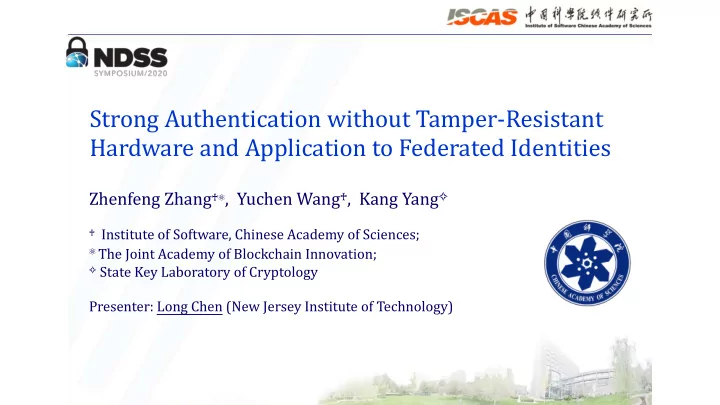

Strong Authentication without Tamper-Resistant Hardware and Application to Federated Identities Zhenfeng Zhang ♰⚛ , Yuchen Wang ♰ , Kang Yang ✧ ♰ Institute of Software, Chinese Academy of Sciences; ⚛ The Joint Academy of Blockchain Innovation; ✧ State Key Laboratory of Cryptology Presenter: Long Chen (New Jersey Institute of Technology)
Shared Credential Authentication � Mechanism has dominated the realm of authentication for decades ❖ e.g., password (weak authentication) ❖ User’s credentials stored in centralized repositories at servers ❖ Explicitly transferred from user to server � The shared credentials can be stolen in batches or captured ❖ From breached centralized repositories ❖ Through phishing attacks
Strong Authentication � Strong authentication — cryptographic identification protocol ❖ A claimant proves its identity to a verifier via challenge-response ❖ The claimant demonstrates the knowledge of secret keys with crypto ❖ Secret keys are not transferred over the channels, eliminate the risks � Mechanisms can be built with symmetric-key/public-key cryptos ❖ The claimant generates a MAC value on a challenge with a secret-key ❖ The claimant digitally signs a challenge message with a private-key ❖ e.g., HMAC and ECDSA algorithms
How to Store Secret-keys for Strong Authentication? � Tamper-resistant hardware modules ❖ Highly recommended by FIDO and W3C ❖ FIDO Universal Authentication Framework ❖ W3C Web Authentication Specification � The issues with a tamper-resistant hardware module ❖ The module becomes another thing to be remembered to carry ❖ The secret would lost if the module/device is broken or lost ❖ Decrease usability of the strong authentication scheme
How to Store Secret-keys for Strong Authentication? � Model for strong-auth without tamper-resistant hardware modules � The adversary’s capabilities ❖ Obtain PW-wrapped credentials ❖ Capture authentication tokens � The security goals ❖ Off-line dictionary attacks are infeasible ❖ Existential forgery of an authentication token is infeasible
How to Store Secret-keys for Strong Authentication? � Off-line attacks under the model against strong authentication with symmetric-key crypto (MAC) / public-key crypto (DSA)
Strong Authentication with Password-based Credentials � The Registration Phase � The Authentication Phase � The Secure Construction of Password-based Credential
Password-based Credentials � Setup algorithm � Key Generation algorithm � Issue algorithm � The Sign Algorithm � The Verify Algorithm
Password-based Credentials � Setup algorithm � Key Generation algorithm � Issue algorithm � The Sign Algorithm ❖ randomize-then-prove ❖ SPK can be standardized signature algorithms [ISO/IEC 14888-3:2018] � The Verify Algorithm
Password-based Credentials � Setup algorithm � Key Generation algorithm � Issue algorithm � The Sign Algorithm ❖ randomize-then-prove ❖ SPK can be standardized signature algorithms [ISO/IEC 14888-3:2018] � The Verify Algorithm
Password-based Credentials � Setup algorithm � Key Generation algorithm � Issue algorithm � The Sign Algorithm � The Verify Algorithm
Password-based Credentials � Setup algorithm � Key Generation algorithm � Issue algorithm � The Sign Algorithm � The Verify Algorithm
Password-based Credentials � Security Model of PBC and Provable Security
Strong Authentication with Password-based Credentials � Implementation of PBC-based strong authentication ❖ Common cryptographic libraries • Standardized elliptic curves, not require pairing-friendly curves • OpenSSL, Bouncy Castle, sjcl,… ❖ Mainstream programming language, e.g., C/C++, Java, JavaScript,… ❖ Across devices, e.g., mobile and desktop ❖ PBC-backup for devices broken or lost • Cross device backup • Cloud server backup
Strong Authentication with Password-based Credentials � Deployment of PBC-based authenticator and AUTH ❖ PBC authenticators deployed with • OS API (e.g., Android’s Keystore) • Browser API (e.g., W3C’s AuthAPIs) ❖ PBC-AUTH for both C/S and B/S architecture • Server (Protect key with hardware) • Client (i.e., Application) • Browser Extension
Federated Identities with Password-based Credentials � Identity federation: SAML 2, OAUTH 2.0, OpenID Connect ❖ FAL-3: holder-of-key assertion (HoKA), a reference to a key held by a user, RP requires the user to prove possession of the key (PoPK) � Holder-of-key assertion mechanisms via certificates ❖ Require tamper-resistant hardwares to protect the private keys ❖ IdP cannot both preserve the privacy of users and support HoKA � Holder-of-key assertion mechanisms via PBCs ❖ Without requirement of tamper-resistant hardware for users ❖ Support privacy-preserving HoKA and PoPK
Federated Identities with Password-based Credentials � Holder-of-Key Assertion & Proof-of-Possession of Key with PBCs
Federated Identities with Password-based Credentials � Holder-of-Key Assertion & Proof-of-Possession of Key with PBCs
Federated Identities with Password-based Credentials � Holder-of-Key Assertion & Proof-of-Possession of Key with PBCs
Federated Identities with Password-based Credentials � Privacy-Preserving Holder-of-Key Assertion & PoPK with PBCs
Federated Identities with Password-based Credentials � Privacy-Preserving Holder-of-Key Assertion & PoPK with PBCs
Federated Identities with Password-based Credentials � Privacy-Preserving Holder-of-Key Assertion & PoPK with PBCs
Performance Evaluation � AUTH-x strong authentication, x-ECDSA/PBC with/without tamper- resistant hardware at user-end
Conclusions and Take-aways � Strong authentication without tamper-resistant hardware modules ❖ Highly practical construction from PBCs ❖ Resistant against offline attacks & token-forgery attacks � Federated identity system from PBCs ❖ User-IdP strong authentication ❖ (Privacy-preserving) holder-of-key assertion � User-friendly and easy-to-implement ❖ On general-purpose devices, via common programming languages ❖ Authenticator backup in case of devices broken/lost
Thanks for the attention ! Strong Authentication without Tamper-Resistant Hardware and Application to Federated Identities Zhenfeng Zhang ♰⚛ , Yuchen Wang ♰ and Kang Yang ✧ ♰ Institute of Software, Chinese Academy of Sciences; ⚛ The Joint Academy of Blockchain Innovation; ✧ State Key Laboratory of Cryptology Contact: zhenfeng@iscas.ac.cn, yuchenwang@tca.iscas.ac.cn
Recommend
More recommend